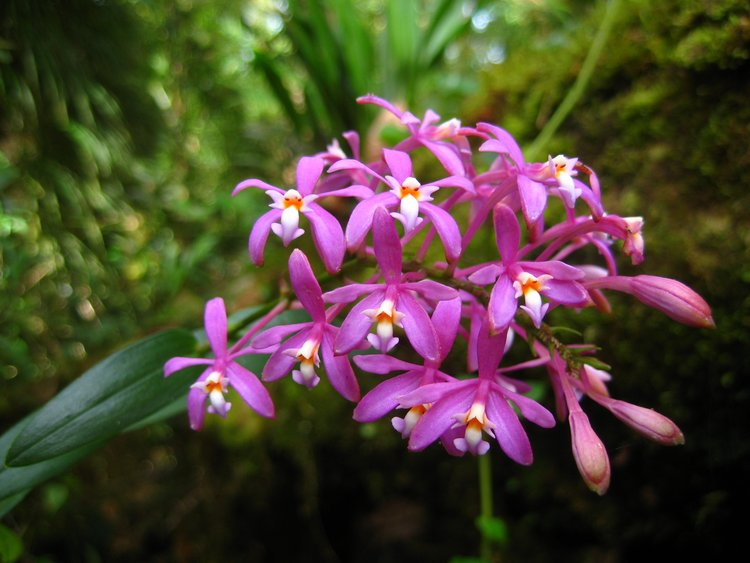

Epidendrum pachytepalum Hágsater & E.Santiago 2006 GROUP Oerstedella SUBGROUP Aberrans
Photo by © Denis Elizondo Delaru and his Flickr Orchid Photo Website


 LATE
LATE 

Common Name The Thick Sepal and Petal Epidendrum
Flower Size .8" [2 cm]
Found in Costa Rica and Panama in high montane oak forests at elevations of 2200 to 3200 meters as a large to giant sized, cold growing terrestrial or epiphyte with erect, simple, canelike, terete, thin, straight stems carrying 10 to 15, all along the apical 3/4's of the stem, alternate, subcoriaceous, lanceolate, acuminate, smooth, margin entire leaves that blooms in the winter, later spring and fall on a terminal, racemose, occuring only once, all the flowers above the rachis, peduncle, short, thin, terete, provided with one basal, narrowly lanceolate, acuminate bract, lax, secund, 3.2 to 5" [8 to 12.5 cm] long, successively 3 to 27, 5 to 34 flowered inflorescence with shorter than the ovary, linear-lanceolate, acuminate floral bracts.
"Epidendrum pachytepalum belongs to the GROUP Oerstedella which is characterized by the sympodial habit, mostly verrucose stems, and the rostellum which is transverse to the column instead of parallel, forming a wide, open sinus, and SUBGROUP Aberrans which has small, membranaceous flowers with a prominent clinandrium-hood, with unequal pollinia, the inner pair much smaller than the outer pair, and the pollinia very flat and translucent. The species is recognized by the somewhat large flowers for the group, fúchsia colored, with base of the lip and calli orange, and two purple spots on the apical sides of clinandrum-hood visible when seen from the front, the sepals and petals fleshy thickened towards the apical margins, the linear pollinia about 3/4 the size of the outer pair and centered, the fleshy midlobe has subguadrate wings near the apex. Epidendrum atypicum Hagsater has a simple midlobe of the lip, and very prominent clinandrium-hood nearly twice as along as the body of the column, the inner pollinia are only half as large as the outer pair, and located towards the apex of the pollinarium. It is closely related to E. crescentilobum Ames which has somewhat smaller flowers and a clearly 4-lobed lip, the midlobe membranaceous, not fleshy-thickened, the inner pollinia are located towards the thinner end of the outer, larger pair." Hagsater etal 2006
Synonyms
ReferencesW3 Tropicos, Kew Monocot list , IPNI ; Icones Orchidacearum 8 Plate 810 Hagsater and Sanchez 2006 see recognition section; Icones Orchidacearum 8 Plate 821 Hagsater and Sanchez 2006 see recognition section; * Icones Orchidacearum 8 Plate 865 Hagsater & Sanchez 2006 drawing fide; Icones Orchidacearum Vol 8 Plate 893 Hagsater & Sanchez 2006 see recognition section; Orchids of Costa Rica Vol 3 Morales 2009 photo fide;
--------------------------------------------------------------------------------------------------------------------------